BIOLOGY NOTES
Created By Boniventure Yohana Salumu
Phone no:0757388430 or 0789434527 or 0688836550
TOPIC ONE:INTRODUCTION TO BIOLOGY
The Meaning of Basic Biological Concepts and Terminologies
Biology
Biology is derived from two Greek words, that is, bios which means life and logos or logia which means study or knowledge.
So biology can be defined as a branch of science which deals with the study of life. The term biology can also be defined as a branch of science which deals with the study of living things or organisms.
Biologist
A person specialized in the study of biology
Life
Life means being alive or existing. Something is alive or existing if it possesses life processes. The life processes are growth, movement or locomotion, respiration, excretion, reproduction, sensitivity and nutrition.
Organism
Organism is anything which has life. It is the other name of a living thing. Organisms are made up of cells.
Cell
A cell is a basic unit of living things. The cell has three main parts, cell membrane, cytoplasm and nucleus. Cells which make up plants are called plant cells and those which make up animals are called animal cells.
Some organisms are made up of one cell. They are called unicellular or single-celled organisms e.g. amoeba, euglena and yeast. Some organisms are made up of many cells, they are called multi cellular organisms e.g. animals, plants, and most fungi.
The Characteristics of Living Things
Outline the characteristics of living things
Movement/locomotion
All living organisms are capable of movement. Movement is the change of position of the whole organism or just part of an organism. For animals and unicellular organisms the movement is of the whole body. This is known as locomotion. Most animals move about using legs, wings or fins. Unicellular organisms such as amoeba, paramecium and euglena use the locomotory structures pseudopodia, cilia and flagella respectively.
In plants only part of it may move towards different factors such as light, water, gravity etc. They move by growing. Their roots grow down in the soil and their shoots grow up into the air or towards a source of light.

Irritability (sensitivity)
Irritability is the ability of an organism to respond to a stimulus. Stimulus (plural; stimuli) is anything that causes a response in an organism.
Examples of stimuli include: an alarm clock, a smell of breakfast cooking and a fly landing on your skin.
All living things are sensitive to certain changes in their surroundings, that is, they are aware of what is happening around them. This is possible because they have special organs known as sense organs by which they detect these changes.
Examples of sense organs include: eyes for vision (sight); skin for temperature, touch, pressure detection; tongue for tasting; nose for smelling; and ears for hearing and body balance.
Plants do not have sense organs but are still able to detect and respond to things like gravity, water and light.

Feeding (Nutrition)
All living things need food to provide energy for such activities such as growth, repair and health.
Animals get their food by eating other living things or food materials that were once living things. Herbivores (e.g. rabbits) eat plants, carnivores (e.g. lions) eat other animals, and omnivores (e.g. humans) eat animals and plants. Plants make their own food through the process called photosynthesis.
The process of taking in food, synthesizing it, digesting and oxidizing it to release energy or build the body is called nutrition.

Respiration
Respiration is the breaking down of food materials within cells to release energy.
Respiration usually involves the use of oxygen. All living things need energy for movement, growth and development, and functioning of body organs.

Excretion
All living things produce wastes such as carbon dioxide, water, urea, ammonia etc.. Some of these chemicals if left to accumulate in the cells would seriously poison the living organism hence they need to be removed. The process of removing metabolic waste products from the body of living organisms is called excretion.
Waste products are removed from the body by excretory organs such skin, kidneys, lungs and liver.

Reproduction
Reproduction is the process by which living things produce new individuals of their own kind. All living things reproduce, to replace organisms lost by death. If a group of organisms does not reproduce fast enough to replace those which die, the group becomes extinct. Reproduction ensures continuation of life when parent generation dies.
Human beings bear babies; birds hatch chicks; and plants produce seedlings as new organisms, which eventually grow to mature organisms to replace those lost by deaths.

Growth
Growth is defined as an irreversible (permanent) increase in size and dry weight of an organism involving differentiation. All living things need food in order to grow and build up their bodies.
Animals grow until they reach certain adult size, but most plants can grow continuously throughout their lives.
Examples of growth in living things
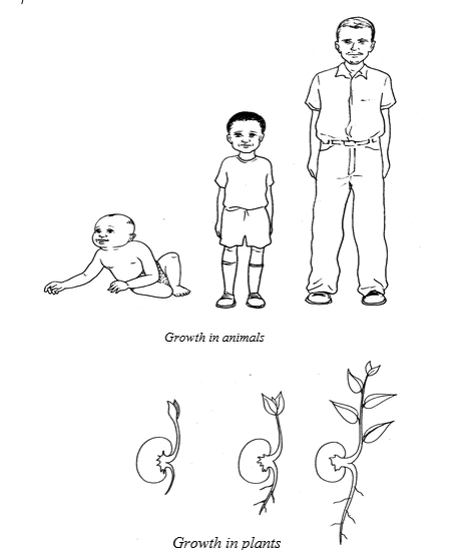
Example 1
Examples of living things
Fucus (bladderwrack)

Streptococci

Diplococci
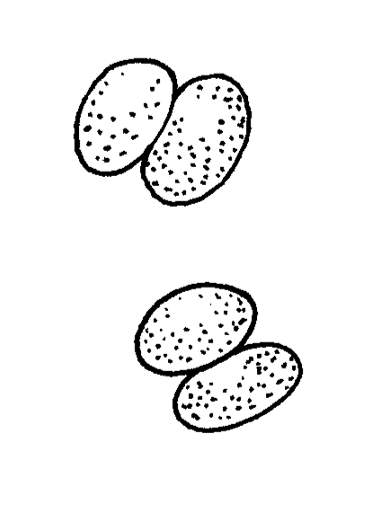
Streptobacilli

Grass snake

Man

Cow

Flagellate bacilli

Mushroom

Male fern

Oak

Amoeba

Fucus (bladderwrack)

Dog fish

Spider

Butterfly

Crab

Millipede

Frog

A table of differences between living things and non-living things
| Living things | Non-living things |
| They respire | Do not respire |
| They grow | Do not grow |
| They respond to stimuli | Do not respond to stimuli |
| They reproduce | Do not reproduce |
| They excrete | Do not excrete |
| They feed | Do not feed |
| They move | Do not move |
Branches of biology
Biology is a subject and it has many branches. The main branches are botany and zoology. Botany is a branch of biology which deals with the study of plants. A person who studies botany is called a botanist. Zoology is a branch of biology which deals with the study of animals. A person who studies zoology is called a Zoologist
Other branches of biology
Mycology: this is the study of fungi. A person who studies mycology is called a mycologist
Bacteriology: this is the study of bacteria. A person who studies bacteriology is called a bacteriologist.
Virology: this branch of biology deals with the study of viruses. A person who studies virology is called a virologist.
Immunology: is concerned with body defense against diseases and foreign substances. A person who studies immunology is called an immunologist.
Entomology: refers to the study of insects A person who studies entomology is called an entomologist.
Parasitology: this branch deals with study of parasites and their effects on living organisms. A person who studies parasitology is called a parasitologist.
Dermatology: It is concerned with medical study of skin and its diseases. A person who studies dermatology is called a dermatologist
Ecology: Is a branch of biology that deals with relationship among living things and between organisms and their surroundings. A person who studies ecology is called an ecologist
Anatomy: Is the study which deals with structure of living things. A person who studies anatomy is called anatomist
Diagram representing branches of Biology

Endocrinology: This is the study of structure of endocrine glands and the hormones associated by them. A person who studies endocrinology is called an endocrinologist.
Histology: Is the study of structure of tissues A person who studies histology is called an histologist
Cytology: Is the study of structure, composition and function of cells. A person who studies cytology is called a cytologist.
Microbiology: Is devoted to the study of organisms that can be seen only with a microscope e.g. bacteria, viruses, some fungi and some protoctists. A person who studies microbiology is called a microbiologist.
Taxonomy: Is the scientific classification of organisms. A person who studies taxonomy is called a taxonomist.
Genetics: Study of heredity and variation in organisms. A person who studies genetics is called geneticist.
The Importance of Studying Biology
Explain the importance of studying biology
The study of biology is very important to man.
The following is an outlines of why the study of biology is important:
- It helps us to understand ourselves better since we are living things.
- Skills and knowledge of biology can be applied to other scientific fields such as agriculture, forestry medicine, nutrition, pharmacy and veterinary science.
- It helps us to understand our environment better and principles of conserving it.
- Biology helps to answer some important questions such as, what do living things need, why do we resemble with a monkey, why do frogs lay many eggs but only few become adults?
- Knowledge of biology helps us to improve our health since causes, symptoms, transmission and treatment are of various diseases are studied in biology.
- Knowledge of biology helps us to avoid our selves from magical beliefs, superstitions and other traditional taboos.
- Knowledge of genetics helps us to clear some common doubts about certain inherited characteristics e.g. albinism, sickle cell anaemia, haemophilia, etc.
- Knowledge of the structure and chemical composition of the organisms enable us to acquire food, clothes and shelter from them.Relationship between Biological Science with other Related FieldsRelate biological science with other related fieldsVeterinary science (Veterinary medicine)Veterinary medicine is the branch of medicine that deals with the diseases of animals. Doctors that treat animals are called Veterinarians. Veterinarians are trained to prevent, diagnose and treat illness in large and small animals. Their work is valuable because many animal diseases can be transmitted to human beings e.g. rabies, tuberculosis, tularemia (rabbit fever) anthrax etc. Basic knowledge of biology is required for successful study of veterinary science.AgricultureAgriculture is concerned with production of useful plants and animals through farming system. Agriculture provides us with almost all our food. It provides materials for clothing and shelter. It provides materials used for making many industrial products such as paints and medicines. Agriculture uses knowledge of biology to improve plant and animal breeding. Genetically modified organisms (GMOs) ensure better quality, early maturity and high yield products. Crop and animal diseases and pests can only be overcome by applying biological knowledge.ForestryA forest is a large area of land covered with trees. It is much more than just trees. It also includes smaller plants such as mosses, shrubs and wild flowers. Forestry is the science of managing forest resources for human benefit. The practice of forestry helps maintain an adequate supply of timber and management of such valuable forest resources such as water, wildlife, grazing areas and recreational areas.Biology helps in improving the qualities of the trees through manipulating the genetic constitution of the particular plant species.Climate, soil and water determine the type of plants to be grown which entirely applies biological knowledge. Use of biological control to combat tree pests applies biological principles.PharmacyPharmacy is the profession concerned with the preparation, distribution and use of drugs. Members of this profession are called pharmacists or druggists. Pharmacy also refers to a place where drugs are prepared or sold The drugs are made depending on the chemical composition of the body of an organism and how they can react with such medicines. Knowledge of biology also helps to know the effects of drugs on living things (pharmacology) and possible remedies to be taken.MedicineMedicine is the science and art of preserving health and treating illness. Medicine is a science because it is based on knowledge gained through careful study and experimentation. It is an art because its success depends on how skilfully medical practitioners apply their knowledge in dealing with patients. The goal of medicine include saving lives, relieving suffering and maintaining the dignity of sick people. Biological knowledge helps the doctors, surgeons and nurses to diagnose, treat and prescribe the right medicine to cure the disease.Biological knowledge will also help them to offer education to the patients on how to prevent themselves from the diseases e.g. purifying drinking water, vaccination against polio, measles and other diseases.NutritionNutrition is the science which deals with food and how the body uses it. People, like all living things need food to live. Food provides substances that the body needs to build and repair its tissues and to regulate its organs and systems. Food also supplies energy for every action we perform. Knowledge of biology helps to identify the type of food required by an individual based on its quality and quantity.A table showing differences between plants and animals
PLANTS ANIMALS (i)They are autotrophic, i.e. they can make their own food They are heterotrophic i.e. they feed on complex organic compounds (ii)Contain chlorophyll, can undergo photosynthesis. No chlorophyll, cannot undergo photosynthesis (iii)Growth occurs in some parts only i.e. root and shoot tips. Growth occurs in all parts of the body. (iv)They have branched bodies They have compact bodies (v)No nerves, muscles, blood system or special sensory cells. Have nerves, muscles, blood system and special sensory cells. (vi)Usually rooted in the ground and do not move from place to place. Not rooted in the ground, move to get food and escape enemies. (vii)Have no digestive system Have digestive system needed to break down food (viii)Cells of plants have cell walls Cells of animals have no cell wallsThe Biology Laboratory
Describe the biology laboratoryA biology laboratory is a room or building specially designed for carrying out biological experiments.A biology laboratory has:- Large windows and big space to allow enough air and light for better ventilation and visibility respectively.
- Shelves – for keeping chemicals, specimens, apparatus and models.
- Supply of gas, electricity and water
- Working benches
- An emergence door in case of danger occurs.
- Preparation room
The biology laboratory rulesBiology laboratory has sophisticated instruments which need to be handled with special care. Chemicals which are being used are potentially harmful and they need a special attention when working with them.The following laboratory rules should be adhered to:- Don’t enter in the laboratory without permission from the teacher or laboratory technician.
- Do not play, or run unnecessarily in the laboratory.
- Do not eat or drink in the laboratory.
- Do not use chemicals or handle apparatus or specimens without instruction from the teacher or laboratory technician.
- Any accident or damage of apparatus must be reported.
- Label chemicals and specimens to avoid confusion.
- Always keep flammable substances away from flames.
- Turn off water and gas taps after use.
- Never point the open end of the test tube to your fellow or yourself when heating.
- Never smell substances, specimens, chemicals or gases directly.
- Wash your hands with soap after the experiment.
- Clean the apparatus and benches after the experiment.
- Return the apparatus and chemicals to their normal position after use.
The Difference between the Biology Laboratory from other School FacilitiesDistinguish the biology laboratory from other school facilitiesDifference between biology laboratory and other school facilities:- Dissecting kits
- Models of different organs and systems
- Refrigerators and ovens for storing and drying specimens
- Animal keeping units
- Chemicals designed for biological experiments
- Preserved specimens of living things
- Gases, electricity and water supply.
Aim: To differentiate biology laboratory from other school laboratories or facilitiesProcedure: let students visit the chemistry laboratory, physics laboratory, the school library, classroom and school store and allow them to perform the following.- Make a list of items that are found in each of the above named areas.
- Compare the list with those which are found in the biology laboratory.
- Construct a table of differences showing a list of items which are found in the biology laboratory and those which are found in the above named school facilities as shown below.
- List items which are found in both the biology laboratory and other school facilities listed above and compare the differences.
Facility / Building Items Biology laboratory Chemistry laboratory Physics laboratory School library Classroom School store Interpretation of Warning Signs on Containers of Laboratory Chemicals and ApparatusInterpret warning signs on containers of laboratory chemicals and apparatusWarning signs on laboratory chemicals and apparatusSome of the chemicals and apparatus used in biology laboratory may be harmful or dangerous. Before starting using any chemical you must know whether the chemical is toxic, flammable, oxidizing, explosive or irritant/harmful. To help you recognize such dangerous substances, the containers of modern chemicals carry special chemical warning signs as indicated below.ToxicToxic substances can cause death. They may be poisonous when swallowed, breathed in or absorbed through the skin. Examples of toxic substances include acids and alkalis, lead II acetate and potassium dichromate.The symbol for toxic substances is represented as shown above.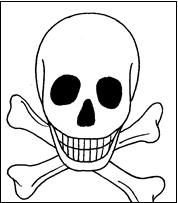 FlammableFlammable substances are substances which can catch fire easily. Examples of such substances include petrol, alcohol, Thomas Baker (Phosphorus yellow or phosphorus red) and potassium metal. These substances normally evaporate fast and therefore should not be brought near open flames. The symbol is as indicated above.
FlammableFlammable substances are substances which can catch fire easily. Examples of such substances include petrol, alcohol, Thomas Baker (Phosphorus yellow or phosphorus red) and potassium metal. These substances normally evaporate fast and therefore should not be brought near open flames. The symbol is as indicated above.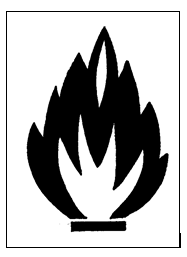 CorrosiveCorrosive substances attack and destroy living tissues. They may destroy the floor, desks as well as metals, examples of corrosive substances are concentrated acids, e.g. sulphuric acid, hydrochloric acid, nitric acid and concentrated alkalis e.g. sodium, potassium and ammonium hydroxides. If by accident a corrosive substance comes into contact with your skin, go to the sink and wash with a lot of water. The symbol is shown above.
CorrosiveCorrosive substances attack and destroy living tissues. They may destroy the floor, desks as well as metals, examples of corrosive substances are concentrated acids, e.g. sulphuric acid, hydrochloric acid, nitric acid and concentrated alkalis e.g. sodium, potassium and ammonium hydroxides. If by accident a corrosive substance comes into contact with your skin, go to the sink and wash with a lot of water. The symbol is shown above. OxidantAn oxidant is a chemical or substance which accelerates burning. Small fires can be made big in the presence of oxidizing agent. Examples of oxidizing agents include potassium permanganate, potassium chlorate, and zinc nitrate.
OxidantAn oxidant is a chemical or substance which accelerates burning. Small fires can be made big in the presence of oxidizing agent. Examples of oxidizing agents include potassium permanganate, potassium chlorate, and zinc nitrate.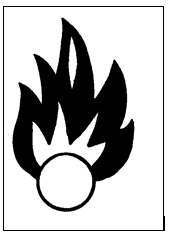 ExplosiveAn explosion is a forceful rapid reaction which involves random throwing of particles
ExplosiveAn explosion is a forceful rapid reaction which involves random throwing of particles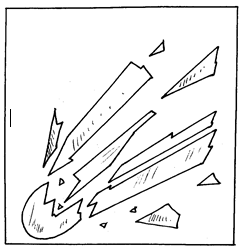 Harmful or irritantHarmful substances have a long term effect. They do not kill immediately. They have a cumulative effect. Therefore careful handling is required.
Harmful or irritantHarmful substances have a long term effect. They do not kill immediately. They have a cumulative effect. Therefore careful handling is required.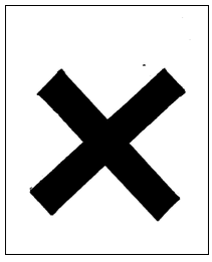 Irritant substances cause pains on the skin or eyes. They can endanger one's health if they come into contact with the skin or eyes for too long. Examples of harmful substances include lead chloride, lead nitrate, lime water ferrous sulphate and manganese (IV) oxideExamples above of some chemical containers with their warning signs.
Irritant substances cause pains on the skin or eyes. They can endanger one's health if they come into contact with the skin or eyes for too long. Examples of harmful substances include lead chloride, lead nitrate, lime water ferrous sulphate and manganese (IV) oxideExamples above of some chemical containers with their warning signs. Activity 6Aim: to investigate chemical warning signs Requirements: varieties of chemical containers Procedure: collect chemical containers. Observe them carefully and identify chemical warning signs on them.Record your results as shown in the table that follows.
Activity 6Aim: to investigate chemical warning signs Requirements: varieties of chemical containers Procedure: collect chemical containers. Observe them carefully and identify chemical warning signs on them.Record your results as shown in the table that follows.Chemical container Warning sign The Common Apparatus and Equipment of Biology LaboratoryIdentify common apparatus and equipment of biology laboratorySome apparatus and equipment used in the biology laboratory.- Microscopes
- Hand lenses
- Thermometers
- Dissecting kits
- Mortar and pestle
- Dissecting trays
- Delivery tubes
- Measuring cylinders
- Bunsen burners
- Test tubes
- Specimen bottles
- Ovens
- A pair of scissors
- Chemical balance
- Funnel
- Test tube racks
- Test tube holders
- Beakers
- Forceps
- Surgical blades
- Microscope slides
- Droppers
- Spatula
- Corks
- Glass straws
- Fridge/refrigerator
- Mounted needle
- Beam balances
- Glass rods
- Scalpels
Microscope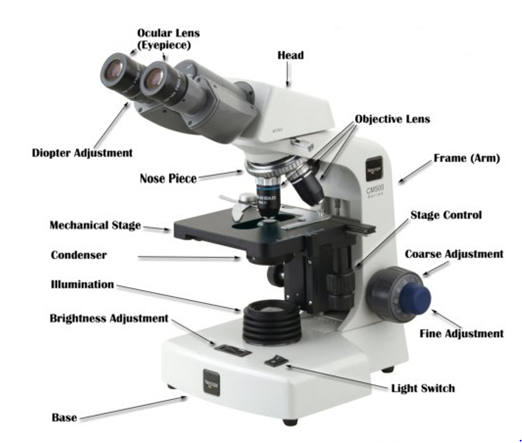 Thermometers
Thermometers Hand lenses
Hand lenses Dissecting kit
Dissecting kit Motor and Pestle
Motor and Pestle Dissecting tray
Dissecting tray Delivery tube
Delivery tube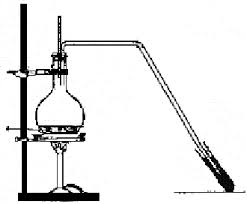 Measuring cylinder
Measuring cylinder Bunsen Burner
Bunsen Burner Test tube
Test tube Specimen Bottles
Specimen Bottles Oven
Oven Pair of scissors
Pair of scissors Funnel
Funnel Surgical blades
Surgical blades Microscopic blades
Microscopic blades Spatula
Spatula Cork
Cork Glass straws
Glass straws Mounted Needle
Mounted Needle Beam balance
Beam balance Glass rod
Glass rod Scalpels
Scalpels Dropping pipette
Dropping pipette Fridge/refrigerator
Fridge/refrigerator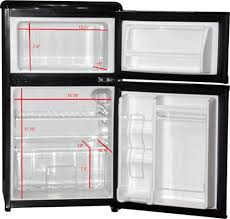 Some common chemicals used in the biology laboratory
Some common chemicals used in the biology laboratory- Benedict’s solution
- Lime water (calcium hydroxide)
- Sodium hydroxide (slaked lime)
- Cobalt chloride
- Hydrochloric acid
- Copper (II) sulphate
- Sudan III
- Alcohol
- Stains e.g. carmine red, methylene blue
- Sodium bicarbonate
- Potassium permanganate
- Iodine solution
Exercise 2In each of the following questions write TRUE for correct statement and FALSE for incorrect statement.- A biology laboratory is a place where biological experiments are conducted……………………………….
- Everything in the laboratory can be tasted ………………
- Warning signs can help someone to avoid accident in the laboratory………………………………………………...
One of the following is not a basic quality of the biology laboratory.- Working benches
- Large windows and big space
- Supply of gas, electricity and water
- Kitchen
Substances which may catch fire easily are said to be- Toxic
- Flammable
- Explosive
- Irritant
An instrument used to measure temperature of the body is called- Chemical balance
- Measuring cylinder
- Thermometer
- Barometer
One of the following is a common reagent used in the biology laboratory- Benedict’s solution
- Potassium iodide
- Sodium acetate
- Barium chloride
Which of the following list of instruments is not related to biology laboratory?- Fridge, a pair of scissors, surgical blades
- Microscope, test tube, thermometer
- Dissecting kit, scalpel, beaker
- Meter bridge, pendulum bob and burette.
The warning sign shown indicates- Explosive substance
- Oxidizing agent
- Flammable substance
- Corrosive substance
 Match the items in list A with the corresponding items in list B.LIST A
Match the items in list A with the corresponding items in list B.LIST A- Used for placing specimen during dissection
- An apparatus used for stirring solution
- A substance which accelerates burning
- Do not play or run in the laboratory
- A common reagent in the biology laboratory
LIST B- Laboratory rule
- Oxidant
- Sudan III
- Dissecting kit
- Glass rod
What do you understand by the following terms?- Laboratory
- Warning sign
Draw warning signs which may be used in bottles carrying a substance which is- toxic
- flammable
- explosive
- harmful
List down any six (6) laboratory rulesState the use of the following apparatus- Specimen bottles
- Test tube holders
- Beam balance
- Beaker
- Mortar and pestle
Draw the following apparatus:- Measuring cylinder
- Mortar and pestle
- Funnel
- Tripod stand.
THE MICROSCOPEMuch of the living world is too small for human eyes to see. Our eyes can only see objects that are larger than 0.1mm. Objects with sizes smaller than 0.1mm can be viewed by using microscopes.What is a microscope?A microscope is an instrument used for viewing objects which are too small to be seen by our naked eyes. It ranks as one of the most important tools of science.- Physicians and biologists, for example, use microscopes to examine bacteria and blood cells.
- Material scientists and engineers use microscopes to study the crystal structures within metals and alloys (metal mixtures) and to examine computer chips and other tiny electronic devices.
There are two types of microscopes- Compound or light microscope
- Electron microscope
Optical or light microscopeAn optical microscope has one or more lenses that refract (bend) the light rays that shine through or are reflected by the specimen being observed. The refracted light rays make the specimen appear much larger than it is.Magnifying glass is the simplest optical microscope, has only one lens. The best magnifying glasses can magnify an object by 10 to 20 times.The compound or light microscopeThe compound or light microscope uses two or more sets of lenses to provide higher magnifications. Each set of lenses functions as a unit and is referred to as lens system. In microscopes with only one objective, the lens system and ocular are mounted at opposite ends of a tube. In microscopes with two or more objectives the objectives are mounted in a rotating nose piece connecting to the end of the tube opposite the ocular. The person operating the microscope rotates the nose piece to align one of the objectives with the opening in the end of the tube.The workings of electron and compound microscope Electron microscope – Uses electrons to illuminate the specimen and can reveal much more structures than light microscope can do.Light microscope – Uses light to illuminate the specimenParts of the light microscope and their functions Parts of the light microscope has the following functions:
Parts of the light microscope has the following functions:- Eyepiece – Magnify objects under observation since it consists of magnifying lenses.
- Body tube – Hollow tube attached to the arm. Its function is to hold eyepiece lens and revolving nose piece.
- Revolving nose piece – Holds objective lenses in place. Position of the objective lenses can be changed by manipulating the revolving nose piece.
- Coarse adjustment knob – It lowers and raises the body tube so that a clear image is obtained.
- Fine adjustment knob – Raises and lowers the body tube to obtain a fine focus.
- Objective lens – Brings image into focus and magnifies it.
- Stage – This is a place where specimen to be observed is placed
- Clips – Hold the slide or specimen in position
- Mirror – Reflects and directs light to the object under observation.
- Diaphragm – Is an aperture that regulates the amount of light passing through the condenser to illuminate the specimen
- Condenser – Concentrates light reflected by the mirror.
- Base or stand – Supports the microscope steadily
- Arm or limb – Supports the body tube and stage. It is used to hold the microscope
- Hinge screw – Raises and lowers the stage.
MagnificationMagnification power is symbolized by a number and abbreviation X. For example a 10X magnifying glass magnifies an object by 10 times. An object is magnified by multiplying the eyepiece lens magnification and objective lens magnification.Example:Magnification = eyepiece lens x objective lens magnification= 10 × 20= X200A table of magnificationEye piece lens magnification Objective lens magnification Total magnification 5 20 X100 10 20 X200 15 10 X150 10 25 X250 20 20 X400 How to use a microscope- Turn on your microscope light
- Turn the nose piece so that the small (low power) objective lens clicks into place. Always start with low power lens in place.
- Place the prepared slide on the center of the stage under the clips so that the object is in the center of the opening. Make sure the cover slip is on top
- With your eye at stage level, use the coarse adjustment to bring the object and the low power objective lens as near to each other as possible. The objective lens should not touch the cover slip
- Now with your eye to the eyepiece, slowly move the coarse adjustment to increase the distance between the object and the lens. Continue this until the image is focused.
- Adjust the diaphragm so that the object can be seen as clearly as possible
- To observe the object under medium and high powers, rotate the revolving nose piece to bring the next highest objective lens into position. Make sure you hear the 'click' to ensure that the objective lens is in place. Then, focus using the fine adjustment only.
Ways of handling and carrying a light microscope- Use both hands to carry the microscope. One hand should hold the base and the other hand should hold the arm.
- Always place the microscope on the desk or table carefully and gently and never place it at the edge of the bench.
- Keep the microscope in an upright position when using liquids or when not in use.
- Keep the stage clean and dry. If any liquids are spilled on the microscope, wipe them up immediately with a piece of tissue.
- Focus with the low-power objective lens first.
- Focus by moving the lens away from the slide, that is, by increasing the working distance.
- Consult your teacher if the lenses are dirty.(viii) Consult your teacher if the adjustments do not work freely.
- When your work is completed, move the low power objective lens into place and remove your slide.
- Keep your microscope covered when it is not in use and keep your work area clean and tidy.
ELECTRON MICROSCOPEThis type of microscope uses a beam of electrons rather than a beam of light to produce magnified images. Electron wave lengths are much shorter than those of visible light. As a result electron microscopes can resolve much finer detail than light microscope can do. Types of electron microscopes
Types of electron microscopes- Transmission electron microscope (TEM) This type of a microscope passes a broad beam of electrons through a specimen slice a few hundred angstroms thick.
- Scanning electron microscope (S E M) This microscope scans a focused beam across the surface of the specimen.
Other kinds of microscopesScanning probe microscope The microscope scans a specimen with a sharp point called a probe.The ion microscope (field -ion microscope) It is used to examine metals. It creates an image of the crystal structure of the tip of an extremely sharp metal needle. An electric field applied to the tip repels charged helium, neon or argon atoms which spread out and strike a special screen. The screen glows where the atoms strike it, forming an image of the arrangement of atoms in the metal.
The Meaning and Importance of First Aid at Home and at SchoolExplain the meaning and importance of first aid at home and at schoolFirst Aid is an immediate help which is given to a sick or injured person before sending him/her to the hospital for further treatment.FIRST AID KITImportance of First Aid- Saves life
- Reduces fear of death
- Brings hope and encouragement to the patient
- Relieves the victim’s pain
- Prevents the illness or injury from becoming worse
- Helps a person to recover from shock
- It shows spirit of helping each other.
Components of the First Aid Kit and their UsesIdentity components of the first aid kit and their usesFirst Aid kit is a small box which is used to keep instruments and chemicals for First Aid. The first Aid kit should be placed in a safe and accessible place.Components of the First Aid kit- A pair of scissors
- Gauze
- Assorted bandages
- Adhesive plasters
- Cotton wool
- New razor blade
- Gentian violet (GV)
- Petroleum jelly or Vaseline
- Safety pins
- Iodine tincture or spirit
- Soap
- Anti-pain (pain killers) e.g. Panadol
- Sterilized forceps and pins
- Liniment
- A pair of tongs
- Antibiotic solution
Uses of the instruments and chemicals in the First Aid kit- A pair of scissors:is used for cutting dressing materials such as gauze, bandages·
- Gauze:is used to cover the wound to prevent dirt and micro-organisms from entering.
- Assorted bandages: are used for securing an injured part in order to protect and support it.
- Adhesive plaster:are used for covering minor wounds/cuts and grazes·
- Cotton wool:is used for cleaning and drying wounds and applying medicine·
- New razor blade:used for cutting any flaps of skin when cleaning the wound.
- Gentian Violet (GV):is used as an antiseptic to clean wounds.
- Petroleum jelly or Vaseline:used for treatment of burns
- Safety pins:used for holding/securing bandages.
- Iodine tincture or spirit:used for cleaning wounds to reduce bleeding.
- Soap:is used for washing wounds, hands and medical facilities.
- Anti-pain (pain killers):used to reduce pain.
- Sterilized forceps and pins:are used for removing splinters and grit from wounds.
- Liniment:used to reduce muscle pains.
- A pair of tongs:used for holding pieces of bandages when cleaning the wounds.
- Antibiotic solution:is used for applying in the wounds for killing micro-organisms.
FIRST AIDERThe First Aider is a specialist who gives first aid.Qualities of the first Aider- She/he should have ability to assess the problem and give immediate and appropriate help.
- She/he must be able to act quickly, quietly, calmly
- She/he should be sympathetic to the victim
- She/he should be able to recognize dangerous signs and give immediate help for example detecting immediately if -breathing has stopped or is failing -there is severe bleeding-poisoning-fractures
- She/he should be able to help the injured person without unnecessary movement
Precautions to be observed by the First AiderThe First Aider should keep himself/herself safe to avoid dangers from the patient. Some of the dangers that s/he may face include infection by pathogens such as viruses and bacteria.So they should:- Wear protective gloves to avoid contact with blood
- Wear eye protection
- Wear masks and gowns.
First Aid can be rendered to the victims of- Drowning
- Muscle cramps
- Bleeding
- Poisoning
- Hiccups
- Suffocation
- Bruises
- Fainting
- Burns
- Sprain
- Bone fracture
- Snake bite
Procedures of Giving First Aid to Various VictimsOutline procedures of giving first aid to various victimsSNAKE BITESA poisonous snake has two fangs one on each side of the upper jaw. The fangs are as sharp as needles. At the root of the fang there is a poison gland. When the snake strikes, it jabs downwards hitting the skin with its fangs and releases a few drops of venom.Venom is the poison of the snake The action of striking forces the poison out and injects into the victim’s skin.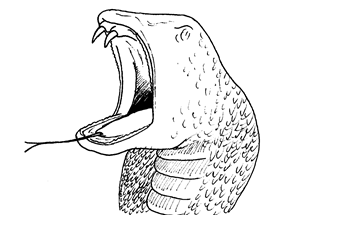 Sign and symptoms
Sign and symptoms- Immediate pain and swelling after the bite
- The skin becomes purple One or two punctured points may be seen where the fangs passed through the skin
SCORPION BITEScorpions are armed with a single curved stinger in the tail. Through this, they inject powerful venom that may produce convulsions and temporary paralysis. The affected area feels as though is had been burned with a hot sparkHow to give first Aid to a victim of scorpion bite
The affected area feels as though is had been burned with a hot sparkHow to give first Aid to a victim of scorpion bite- Apply tourniquet
- Put ice on the injured area to relieve pain and prevent spread of the poison
- Treat for shock
- Rush the person to the hospital
DOG BITEWhen someone is bitten by a dog, keep the dog under observation to see whether it has rabies. Rabies is one of the worst diseases known. It is caused by a virus which is present in the saliva of the infected animal.If the animal has rabies, it will become restless, excitable, refuse to eat and barking tone will change. Later the dog then starts barking excessively.How to help a victim of dog bite- Wash your hands well with soap and water
- Wash the wound thoroughly with soap and water to remove the animal’s saliva using running water.
- Cover the wound with clean gauze.
- Bandage it carefully
- Take the victim to the hospital.
INSECT BITES- Spider bites : Some spiders have a harmless venom to man. But the black spiders can be dangerous to man. The injured person becomes weak and dizzy, feels nauseated and the muscles of the stomach may become hard especially in children.
- Black and fire ants, bees : When a person has been stung by e.g. bees, severe pains are felt immediately.The person may be shocked, itching and swelling may follow.
A victim of spider bite can be helped by sending him/her to the hospital.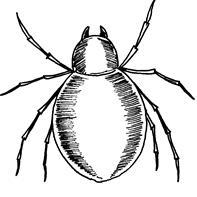 How to help
How to help- Remove the insect’s sting
- Apply household ammonia and ice cubes
- Treat for shock
CHOCKINGChoking is caused when food or a foreign object becomes lodged in the windpipe.Have you ever been with a person who is chocking? Did you know what to do?When you are with a person that is chocking, first notice if person can talk, breath or cough. If so stay with that person until the air way is cleared by coughing.Caution: Do not try to slap the person on the back. The slapping may cause the food to become more deeply ledged in the wind pipe. If a person cannot talk or cough and appears to have a difficult in breathing, apply quick abdominal thrusts i.e. Heimlich maneuver as follows;
If a person cannot talk or cough and appears to have a difficult in breathing, apply quick abdominal thrusts i.e. Heimlich maneuver as follows;- First stand behind the chocking victim
- Put your arms around the person, placing your firsts just below the breast bone as shown above.
- Give a series of quick, sharp upward and inward thrusts
These thrusts push in on the diaphragm and the thoracic cavity suddenly decreasing its volume.Air pressure is exerted below the obstruction which projects it forcefully from the windpipe.POISONINGA poison is any substance which can loss of one’s life or seriously endanger health when taken into the body.In every household there are different kinds of things which are poisonous. Some are deadly even on a very small dose. Others may be more or less harmless when taken in small quantities.Examples of poisonous substances at home are kerosene, disinfectants, paints, medicines, artificial fertilizers, etc.First aid to poisoning- Look for the poison
- Identify the poison
- Neutralize the poison by giving the victim plenty of milk to drink or egg white or water.
- Induce vomiting if the poison is not strong acid or alkali as these are corrosive substance.
- If the problem is severe, rush him or her to the hospital.
BONE FRACTUREA person with a bone fracture experience the following;- Severe pain around the injured part
- Lack of movement
- Swelling
- Fainting or shock
How to help- Treat for a shock
- Keep the patient absolutely quite
- Prevent further damage to injured part by using a splint.
BONE DISLOCATIONSThese are bones which have come out of place at a joint.How to help- Bring the bone back into fixed position
- Bandage it firmly in place so that it does not slip out again
SHOCKShock is a sudden violent disturbance of the mind or emotionCauses of shock- Bad news
- Severe illness
- Heavy bleeding
- Dehydration
- Severe burns
- Accident
Ways of preventing shock- Lie down the person with his feet higher than his head
- Loosen the belt and shoes
- If the person is conscious give him some tea or any soft drink.
- Treat his/her wounds if any
- Stop any bleeding Keep the person warm if he/she feels cold
ELECTRIC SHOCKHow to help- Switch off the electricity immediately
- If not possible to switch off the electricity, take the victim away from the source of electricity using a dry wooden material or rope.
- Loosen any tight clothes
- If the person is unconscious, apply mouth to mouth respiration
- Treat for shock
- Take the person to the hospital immediately
BRUISESA bruise is an injury beneath the skin. Bruises can be identified by pain, swelling or a mark under the skin.How to treat bruises- Wash your hands using water and soap
- Wash the bruised part
- Apply cold clothes or ice immediately to reduce pain and swelling
- If swelling continues take the victim to the hospital
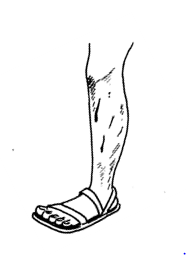 VOMITINGVomiting is an involuntary ejection of substance from the stomach through the mouth.Possible causes of vomiting
VOMITINGVomiting is an involuntary ejection of substance from the stomach through the mouth.Possible causes of vomiting- Allergic reactions
- Diseases e.g. malaria
- Physiological condition e.g. pregnancy
- Food poisoning
- Unpleasant smell or taste
- Drinking a lot of water when thirsty.
How to help- Give the person a rehydration drink or oral rehydration salts solution.
- Allow the person to have a complete rest
- If vomiting continues, take the patient to the hospital.
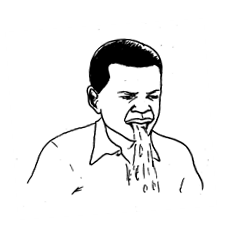 MUSCLE CRAMPSMuscle cramps occur as a result of uncontrolled muscle spasms and contraction.How to help
MUSCLE CRAMPSMuscle cramps occur as a result of uncontrolled muscle spasms and contraction.How to help- Lay the victim down
- Massage the cramped area gently
- Apply some anti-cramp ointment to the affected area
- If the problem persists seek for a medical help
Muscle cramp can cause;- Severe pain
- Loss of movement
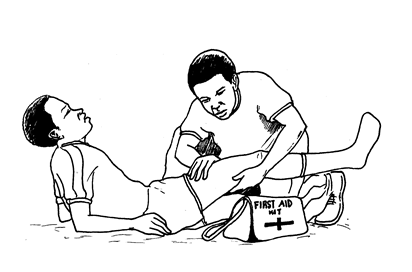 DROWNINGDrowning is a situation where someone has stopped breathing due excessive drinking of water following sinking into water.Offering first aid to a drowned victim
DROWNINGDrowning is a situation where someone has stopped breathing due excessive drinking of water following sinking into water.Offering first aid to a drowned victim- Lay the person on his back and tilt his head backwards so that his mouth falls forward
- Pull the tongue forward.Use a dry cloth to hold the tongue.
- Hold his nose close with your fingers
- Carry out mouth to mouth breathing by blowing gently into the person’s mouth about 30 times a minute but do not blow too hard.This process is called artificial respiration.
- Keep the person warm.
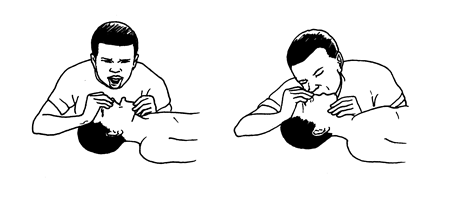 FAINTINGFainting is caused by a temporary fall in the blood supply to the brain, sometimes brought on by emotional shock or prolonged standing.How to help
FAINTINGFainting is caused by a temporary fall in the blood supply to the brain, sometimes brought on by emotional shock or prolonged standing.How to help- Keep the victim lying down with his/her legs raised in order to maintain blood pressure in the brain.
- Do not try to warm the victim.
- Loosen any tight clothing around the neck, chest and waist.
- Supply the patient with plenty of fresh air by fanning or mouth to mouth respiration.
- If there is no improvement rush the victim to the hospital.
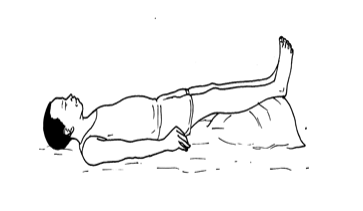 BLEEDINGHow to help the victim(a) Severe cuts
BLEEDINGHow to help the victim(a) Severe cuts- Severe bleeding with blood flowing out rapidly must be stopped at once by pressing with fingers directly on the wound or pressing the edges of the wound together.
- Lay the victim down.
- If the wound is in a limb raise it provided it is not fractured.
- When the bleeding has slowed down press a pad of material over the wound and tie it rapidly in place.
- If blood oozes through, apply more material on top of the original pad.
(b) Simple cuts- Wash your hands well by using soap and water
- Wash the wound
- Cover the wound with clean dressing dipped in iodine solution and bandage the wound
(c) Nose bleeding Bleeding usually occurs near the tip of the nose. The bleeding may be a result of diseases such as- High blood pressure
- Rheumatic fever Or
- Injury
Nose bleeding is also likely to occur at high altitude as a result of cold.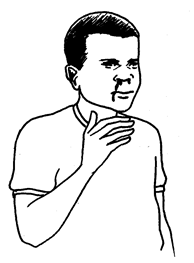
A nose bleeding victimHow to help- Let the victim sit quiet. This makes the heart beat to slow down and hence reduces bleeding.
- Let the victim lean the head slightly backward or make him/ her lie down on his/ her back.
- Press on the side of the nose where the blood is flowing for about 10 minutes.
- Allow the victim to breath through the mouth
- Apply cold, wet compression over the nose and face. If this does not work take the victim to the hospital
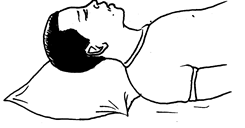
The right position to offer first aid to a nose bleeding victimBURNS AND SCALDSA burn is caused by dry heat e.g. flame of hot object. A scald is caused by a steam or boiling water. The treatment is the same for both burns and scalds except that in scalds any wet clothing should be carefully removed while in burns clothing should be left in place. If clothes are burning cover the victim with a heavy blanket to cut off the air supply.Dip the burning limb into clean cold water or press the affected area gently with an ice block. Do not break the blisters. Cover the injured area with clean dry cloth to keep away bacteria entering the damaged tissue. If the situation is serious take the victim to the hospital immediately.CHEMICAL BURNS (ACIDS AND ALKALIS)How to help- Strip off all clothing which has been contaminated by the chemical.
- Wash the affected area with plenty of water.
- Apply moist packs soaked in a weak solution of baking soda.
- Vinegar can be used for alkaline burns.
HICCUPSHiccups is due to involuntary contraction of the respiratory muscle, giving a characteristic soundHow to help- Pulling out the tongue
- The victim may swallow finely crushed ice
- Holding a breath for a long time may also help
- Children can be given a teaspoonful of a weak solution of sodium bicarbonate or lemon juice.
activity 1Living and non-living thingsAim: to explore living and non-living things around the schoolProcedure:Go around the school surroundings. Identify varieties of living and non living things you see.Make a list of living and non – living things in a tabular form as shown below.
List of living things List of non-living things Relationship between Biological Science with other Related FieldsRelate biological science with other related fieldsVeterinary science (Veterinary medicine)Veterinary medicine is the branch of medicine that deals with the diseases of animals. Doctors that treat animals are called Veterinarians. Veterinarians are trained to prevent, diagnose and treat illness in large and small animals. Their work is valuable because many animal diseases can be transmitted to human beings e.g. rabies, tuberculosis, tularemia (rabbit fever) anthrax etc. Basic knowledge of biology is required for successful study of veterinary science.AgricultureAgriculture is concerned with production of useful plants and animals through farming system. Agriculture provides us with almost all our food. It provides materials for clothing and shelter. It provides materials used for making many industrial products such as paints and medicines. Agriculture uses knowledge of biology to improve plant and animal breeding. Genetically modified organisms (GMOs) ensure better quality, early maturity and high yield products. Crop and animal diseases and pests can only be overcome by applying biological knowledge.ForestryA forest is a large area of land covered with trees. It is much more than just trees. It also includes smaller plants such as mosses, shrubs and wild flowers. Forestry is the science of managing forest resources for human benefit. The practice of forestry helps maintain an adequate supply of timber and management of such valuable forest resources such as water, wildlife, grazing areas and recreational areas.Biology helps in improving the qualities of the trees through manipulating the genetic constitution of the particular plant species.Climate, soil and water determine the type of plants to be grown which entirely applies biological knowledge. Use of biological control to combat tree pests applies biological principles.PharmacyPharmacy is the profession concerned with the preparation, distribution and use of drugs. Members of this profession are called pharmacists or druggists. Pharmacy also refers to a place where drugs are prepared or sold The drugs are made depending on the chemical composition of the body of an organism and how they can react with such medicines. Knowledge of biology also helps to know the effects of drugs on living things (pharmacology) and possible remedies to be taken.MedicineMedicine is the science and art of preserving health and treating illness. Medicine is a science because it is based on knowledge gained through careful study and experimentation. It is an art because its success depends on how skilfully medical practitioners apply their knowledge in dealing with patients. The goal of medicine include saving lives, relieving suffering and maintaining the dignity of sick people. Biological knowledge helps the doctors, surgeons and nurses to diagnose, treat and prescribe the right medicine to cure the disease.Biological knowledge will also help them to offer education to the patients on how to prevent themselves from the diseases e.g. purifying drinking water, vaccination against polio, measles and other diseases.NutritionNutrition is the science which deals with food and how the body uses it. People, like all living things need food to live. Food provides substances that the body needs to build and repair its tissues and to regulate its organs and systems. Food also supplies energy for every action we perform. Knowledge of biology helps to identify the type of food required by an individual based on its quality and quantity.A table showing differences between plants and animalsActivity 1Living and non-living thingsAim: to explore living and non-living things around the schoolProcedure:Go around the school surroundings. Identify varieties of living and non living things you see.Make a list of living and non – living things in a tabular form as shown below.
List of living things List of non-living things
No comments:
Post a Comment